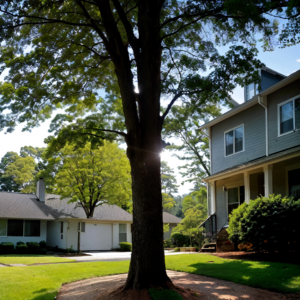
How to tell if my tree is healthy
– Characteristics of healthy trees
– Characteristics of unhealthy trees
– What a tree needs to thrive
– How to help your trees be healthy
Trees provide a lot of benefits for the environment, such as providing oxygen, reducing pollution, and providing shade. It’s important to take care of your trees to ensure they’re healthy and thriving. But, you may be asking yourself, “How can you tell if my tree is healthy?”
We’re here to help you with that question. As ISA Certified Arborists, we’ve been helping people care for their trees at their homes and businesses for years. We’ve compiled information about how to tell if your tree is healthy into two sections.
Characteristics of a healthy tree
Green and full crown
The easiest way to tell if a tree is healthy is by looking at the crown, which is the top part of the tree where the leaves and branches grow. A healthy tree should have a full crown that’s rich in green color (if it is the time of year for green leaves). If you see new leaves or buds growing, that’s a good sign. Additionally, are the leaves the proper size? Are twigs on branches growing?
Root system
A tree’s root system is vital to it’s health, but it’s hard to tell, since they are beneath the ground. A healthy tree will have a well-developed root system, which allows the tree to absorb nutrients and water from the soil.
Characteristics of an unhealthy tree
It’s also important to know the signs of an unhealthy tree. Here are some characteristics of an unhealthy tree:
Thinning crown
If a tree’s crown is thinning, that’s a sign that the tree is not healthy. A thinning crown means that the tree is losing leaves and branches, which can be caused by a lack of nutrients, water, or sunlight.
Color
If the tree is not rich in color and appears anemic, that is another sign of an unhealthy tree. This can be caused by a lack of nutrients, water, or sunlight.
Wilting
If the leaves are wilting, that’s a sign that the tree is not getting enough water. This can be caused by drought, overwatering, or a damaged root system.
Spots or holes on leaves
If there are spots or holes on the leaves, that could be a sign of disease or insect damage.
Dying or dropping branches
If the branches are dying or dropping, that’s a sign that the tree is not healthy. This can be caused by disease, insect damage, or a damaged root system.
Peeling bark
If the bark is peeling, that’s a sign of disease or insect damage.
Early leaf drop
If the leaves are dropping early, that’s a sign that the tree is not healthy. This can be caused by drought, disease, or insect damage.
Fungus
If there is evidence of fungus, that’s a sign of rotting, which can be caused by a damaged root system.
Compacted soil
If the soil around the tree is compacted, that can make it difficult for the tree to absorb nutrients and water.
What a tree needs to thrive
To keep your trees healthy, you need to provide them with the following:
- Sunlight – Trees need sunlight to produce energy, which allows them to grow and thrive.
- Undisturbed soil – Trees need adequate pore space in the soil to absorb nutrients and water. Compacted soil can make it difficult for the tree to absorb what it needs.
- Carbon dioxide and oxygen – Trees need carbon dioxide and oxygen to survive.
- Water – Trees need water to survive, and if they’re not getting enough water, they will show signs of stress.
- Nutrients – Trees need nutrients, such as nitrogen, phosphorus, and potassium, to grow and thrive.
- Proper planting – It’s important to plant trees properly to ensure they’re healthy. A tree that’s planted too deep or too shallow can have problems with its root system.
How to help your trees
Tree health can be complex, and it’s not always easy to tell if a tree is healthy or not. If you think it is, then you should see to the items mentioned above. If you’re unsure, it’s a good idea to call a certified arborist. They can help you diagnose the problem and provide a solution to make sure your trees are in tip-top shape.
The certified arborists at Mockingbird Tree can provide you with a free estimate to help you identify any issues and provide solutions to keep your trees healthy.
Give us a call at 479-633-9876 or click here to schedule a call with a friendly tree professional.
Source:
What makes a healthy tree? – MSU Extension (PDF)
